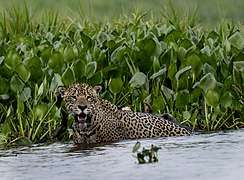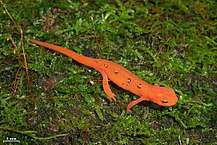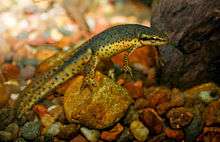List of semiaquatic tetrapods



This is a list of tetrapods that are semiaquatic; that is, while being at least partly terrestrial, they spend part of their life cycle or a significant fraction of their time in water as part of their normal behavior, and/or obtain a significant fraction of their food from an aquatic habitat. The very earliest tetrapods, such as Ichthyostega, were semiaquatic, having evolved from amphibious lobe-finned fish.
Some marine mammals, such as the marine otter, the polar bear and pinnipeds, are semiaquatic, while others, such as the sea otter, cetaceans and sirenians, are fully aquatic. The only fully aquatic nonmarine mammals are several manatees (the Amazonian manatee and some populations of African manatee) and certain small cetaceans (river dolphins, the tucuxi, and some populations of Irrawaddy dolphin and finless porpoise). No bird species is fully aquatic, as all must lay and incubate their amniotic eggs, as well as begin raising their young, on land or ice. Similarly among marine reptiles, sea turtles are almost fully aquatic, but must come ashore to lay eggs. Marine iguanas and partly marine crocodiles (such as the saltwater crocodile and the American crocodile) are all semiaquatic. Most sea snakes are ovoviviparous (live-bearing) and fully aquatic (the exception being the oviparous, semiaquatic sea kraits). A few freshwater snakes are also ovoviviparous and fully aquatic (e.g., Erpeton tentaculatum and Acrochordidae), but the majority are semiaquatic. Most amphibians have an aquatic larval stage and are at least semiaquatic for that reason, but there are many exceptions to this generalization.
The aquatic component of a semiaquatic species' lifestyle may be either obligatory or facultative to varying degrees (examples of the latter are the Arctic fox, jaguar and green iguana).
Note: Dagger symbols, "†", have been used to indicate a listed taxon is extinct.
Mammals
All extant fully aquatic mammals except the sea otter are found in two clades of exclusively aquatic species, Cetacea and Sirenia; the extinct desmostylians may also have been fully aquatic (these groups are thought to have entered the water about 50, 40 and 30 Ma ago, respectively). In contrast, semiaquatic mammals are widely distributed throughout the class. However, extant semiaquatic swimming marine mammals are restricted to Carnivora (among which, pinnipeds apparently appeared about 20 Ma ago). Semiaquatic (carnivorous) rodents have been noted as having larger than normal brains for their size, possibly as a consequence of using their vibrissae for acoustic detection of prey.[1][2]
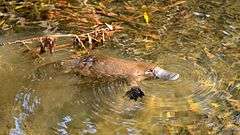
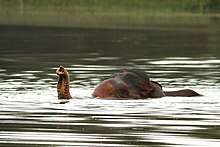
- Monotremes
- Marsupials
- Lutrine opossum
- Water opossum or yapok
- Tenrecs
- Proboscideans
- Sloths
- †Thalassocnus - this marine genus arose about 7 Ma ago, and its most recent species may have been fully aquatic
- Primates
- Allen's swamp monkey
- Crab-eating macaque - feeds opportunistically, but some populations dive for crabs in mangrove swamps
- Proboscis monkey
- Humans - some cultures have practiced marine freediving for subsistence for over a thousand years; in the case of the Sama-Bajau of Maritime Southeast Asia, evidence suggests that genetic adaptations facilitate this lifestyle[3][4][5]
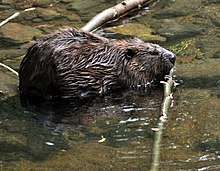
_in_a_partially_frozen_river_Ljubljanica.jpg)
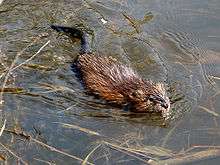
- Rodents
- Castorimorpha - beavers, pocket gophers, and kangaroo rats
- Caviomorpha - New World hystricognaths
- Myomorpha - mouse-like rodents
- 'Crab-eating rats'
- European water vole
- 'Fish-eating rats'
- Link rat or Congo forest mouse (Deomys ferrugineus), an African murid
- 'Marsh rats'
- Muskrat
- 'Swamp rats'
- 'Water mice'
- 'Water rats' or 'wading rats'
- Lagomorphs
- Soricomorphs
- Bats
- Noctilionidae - bulldog bats, a family with only two species, both semiaquatic, one eating aquatic insects, one mainly fish
- Vespertilionidae - vesper bats
- Mouse-eared bats - several species of this mostly insectivorous genus are piscivorous to varying degrees, such as Myotis vivesi (an exclusively marine species), M. pilosus, M. macropus, M. macrotarsus, M. stalkeri, and M. daubentonii[7]
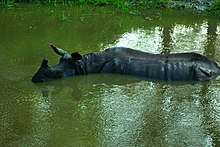

.jpg)
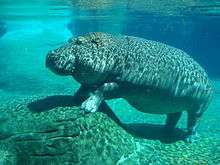
- Carnivorans - while semiaquatic mustelids are widespread, semiaquatic felids are known primarily from South and Southeast Asia, while semiaquatic canids are known primarily from the Neotropics
- Canidae - foxes, jackals and wolves
- Arctic fox - coastal populations exploit marine food sources, such as fish, invertebrates and seaweed, and sometimes hunt ringed seal pups on pack ice
- Bush dog[8]
- Short-eared dog
- British Columbia wolf
- Mustelidae - weasels and otters
- Pinnipedia - seals, sea lions and the walrus
- Procyonidae - raccoons
- Ursidae - bears
- Felidae - cats
- Fishing cat
- Flat-headed cat
- Jaguar - facultatively semiaquatic, i.e., have an affinity for water and exploit aquatic prey in a rainforest or floodplain environment, but may also inhabit more arid habitat[9][10]
- Tiger
- Herpestidae - mongooses
- Viverridae - civets and genets
- Canidae - foxes, jackals and wolves
- Perissodactyls
- Rhinocerotidae - rhinos
- Tapiridae - tapirs
- Artiodactyls
- Bovidae - ruminants
- Cervidae - deer
- Hippopotamidae - hippos are the closest extant relatives of the fully aquatic cetaceans, which are considered a subgroup of artiodactyls
- Tragulidae - mouse-deer[6][11]


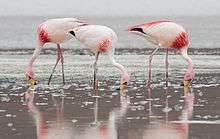
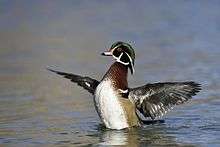
Birds
The great majority of semiaquatic birds are found within three clades whose members are mostly semiaquatic: Aequorlitornithes, Anseriformes and Gruiformes, thought to be about 64, 47 and 41 Ma old, respectively.[12][note 1]
- Accipitriformes - diurnal birds of prey; semiaquatic members are just the sea eagles and osprey
- Aequorlitornithes - a waterbird clade recognized in 2015,[12] which includes most marine birds
- Ardeae
- Aequornithes - wading and diving birds
- Eurypygimorphae
- Charadriiformes - shorebirds
- Auks - including the flightless †Pinguinus
- Gulls, skuas and allies
- Waders - sandpipers, painted-snipes, jacanas, ibisbills, avocets and stilts, oystercatchers and plovers
- Mirandornithes
- Ardeae
- Anseriformes - waterfowl; mostly freshwater, but includes some marine species (e.g. the kelp goose and sea ducks, including the flightless †Chendytes)
- Ducks, geese, and swans
- Magpie goose
- Screamers
- Coraciiformes - many kingfishers are semiaquatic but not the others
- Gruiformes - most but not all of the order is semiaquatic, mainly freshwater but with some (e.g. the clapper and mangrove rails) in brackish or marine habitats
- Passeriformes - dippers are the only semiaquatic passerines
- Strigiformes - nocturnal birds of prey; just fishing owls and fish owls are semiaquatic
Nonavian dinosaurs

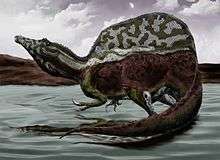
Only a few nonavian dinosaurs are thought to have been semiaquatic. The combination of being oviparous and endothermic seems to have prevented the evolution of fully aquatic dinosaurs.
- Theropoda
- Paraves
- Avialae
- †Ichthyornis - a toothed ornithuran analog of modern seabirds such as gulls and petrels
- †Hesperornithes - a mostly flightless group of diving bird-like ornithurans
- †Dromaeosauridae
- †Halszkaraptor - a mallard-sized basal dromaeosaurid from Mongolia with flipper-like forelimbs
- Avialae
- †Megalosauria
- †Spinosauridae - thought to be piscivores, the group had crocodile-like skulls and includes some of the largest known carnivorous dinosaurs
- Paraves
- †Ornithischia
- †Ornithopoda
- †Hadrosauriformes
- †Lurdusaurus - an unusually heavy-bodied and short-limbed iguanodont conjectured to have been similar in lifestyle to the modern hippopotamus
- †Hadrosauriformes
- †Ornithopoda
Pterosaurs


A number of types of pterosaurs are thought to have been piscivores, and a few are suspected of being molluscivores.
- †Eudimorphodontidae
- †Eudimorphodon - has been found with fish remains in its stomach
- †Rhamphorhynchidae
- †Rhamphorhynchus - commonly found with fish and cephalopod remains in its stomach
- †Dorygnathus - heterodont dentition implies piscivory
- †Ctenochasmatoidea - most had webbed hindfeet and long torsos, adaptations for swimming and floating, and are inferred to have lived in coastal or lake environments
- †Pteranodontia - many in this clade were piscivores
- †Boreopteridae - apparently freshwater surface swimmers or divers
- †Nyctosauridae - later members were similar to ornithocheirans
- †Ornithocheirae - soaring marine forms that were aerial dip-feeders like frigatebirds
- †Pteranodontidae - some may have been pelagic plunge-divers like gannets
- †Azhdarchoidea
- †Azhdarchidae
- †Dsungaripteridae
- †Dsungaripterus - another possible molluscivore
Other reptiles

.jpg)
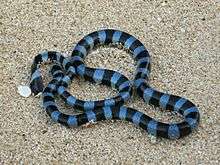
.jpg)
Semiaquatic forms are widely distributed among extant and extinct reptiles, and extinct semiaquatic or fully aquatic marine forms were once ecologically prominent.
- †Choristoderes resembled crocodilians in many respects but were not closely related and were generally more fully aquatic; they survived until the Miocene.
- †Champsosaurus - a Late Cretaceous and early Paleogene sexually dimorphic choristodere in which the females appear better adapted for terrestrial life, probably to facilitate egg-laying
- Crocodilians[note 2] - a great diversity of extinct relatives dating back to the Late Triassic include terrestrial, semiaquatic as well as fully aquatic marine forms
- Lizards
- †Aigialosauridae - semiaquatic Late Cretaceous lizards that evolved into fully aquatic marine mosasaurs, who appeared and rose to dominance after an anoxic event eliminated ichthyosaurs and pliosaurs
- Basiliscus (basilisks) - corytophanids able to run across water
- Chinese crocodile lizard - a monitor lizard relative
- Chinese water dragon - an agamid analog of the green iguana
- Crocodilurus (the crocodile tegu) and Dracaena (caiman lizards) - Neotropical teiid monitor lizard analogs
- Galápagos marine iguana - the only extant marine lizard
- Green iguana - facultatively semiaquatic, i.e., dives into bodies of water when available to escape predators,[13] but may also live in xeric habitats[14]
- Earless monitor lizard - another monitor lizard relative
- Monitor lizards
- Sailfin lizards - agamids also able to run across water
- Waterside skinks - often live along steams and use the water to escape predators
- Snakes
- Turtles are mostly semiaquatic; fully terrestrial examples include box turtles, tortoises, and some Asian box turtles (there are no fully aquatic examples, as all lay their eggs on land)
- Rhynchocephalians - represented today only by the terrestrial tuatara, but several Mesozoic lineages became adapted to aquatic lifestyles
- †Palaeopleurosaurus - probably semiaquatic
Amphibians
Amphibians differ from other semiaquatic tetrapods in that their semiaquatic lifestyle is ancestral, rather than being the result of a secondary evolutionary trend from a terrestrial state back towards an aquatic environment. Thus, they are the only tetrapods to possess gills. All extant amphibians that are semiaquatic or fully aquatic inhabit freshwater habitats, with the exception of the crab-eating frog, which also exploits brackish habitats.
Most amphibians have an aquatic larval stage and thus are at least semiaquatic by virtue of this fact. Many adult amphibians are also semiquatic (while others are fully aquatic or terrestrial). However, some amphibians lack an aquatic larval stage. Some frogs, such as most leiopelmatids, most ranixalids, some leptodactylids, some myobatrachids, Darwin's frog and the Seychelles frog, have nonaquatic tadpoles. Some caecilians, many frogs such as saddleback toads, most sooglossids and the greenhouse frog,[15] and most plethodontid salamanders lay eggs on land in which the larvae develop into adult form before they hatch. The alpine salamander[16] and African live-bearing toads (Nectophrynoides and Nimbaphrynoides)[17] are ovoviviparous and give birth on land. Additionally, about 75% of caecilians are viviparous.
- †Temnospondyls - an early group of amphibians, reaching sizes up to those of crocodiles, whose adult stage was variously fully aquatic, semiaquatic or almost entirely terrestrial. Among the aquatic forms, the Triassic trematosaurids adapted to a marine lifestyle.
- Most anurans (frogs and toads), but not the fully aquatic pipids, or fully aquatic members of other families such as Telmatobiidae
- Some caecilians, such as ichthyophiids, rhinatrematids, Chthonerpeton and Nectocaecilia, but not including other fully aquatic typhlonectids[18]
- Most non-plethodontid salamanders, but not including the fully aquatic amphiumids, cryptobranchids, proteids, sirenids and various neotenic species in other families, such as Ambystoma mexicanum
See also
Notes
- ↑ These dates are without calibration based on the putative late Cretaceous fossil crown avian Vegavis; its inclusion would push back the date for Anseriformes to ~69 Ma.
- ↑ Although all extant crocodilians are semiaquatic, some recently extinct mekosuchine genera, Mekosuchus and Quinkana, were mostly or entirely terrestrial.
References
- ↑ Voss, R. S. (1988). "Systematics and ecology of ichthyomyine rodents (Muroidea) : patterns of morphological evolution in a small adaptive radiation". Bulletin of the American Museum of Natural History. 188: 259–493 (see p. 410). Retrieved 2018-01-11.
- ↑ Peterhans, J. C. K.; Patterson, B. D. (1995). "The Ethiopian water mouse Nilopegamys Osgood, with comments on semi-aquatic adaptations in African Muridae". Zoological Journal of the Linnean Society. 113 (3): 329–349 (see pp. 341–346). doi:10.1111/j.1096-3642.1995.tb00937.x.
- ↑ Nedelman, M. (2018-04-19). "Diving deep on one breath could be in a 'sea nomad's' DNA". CNN. Retrieved 2018-04-20.
- ↑ Zimmer, Carl (2018-04-19). "Bodies Remodeled for a Life at Sea". The New York Times. ISSN 0362-4331. Retrieved 2018-04-23.
- ↑ Ilardo, M. A.; Moltke, I.; Korneliussen, T. S.; Cheng, J.; Stern, A. J.; Racimo, F.; de Barros Damgaard, P.; Sikora, M.; Seguin-Orlando, A.; Rasmussen, S.; van den Munckhof, I. C. L.; ter Horst, R.; Joosten, L. A. B.; Netea, M. G.; Salingkat, S.; Nielsen, R.; Willerslev, E. (2018-04-18). "Physiological and Genetic Adaptations to Diving in Sea Nomads". Cell. 173 (3): 569–580.e15. doi:10.1016/j.cell.2018.03.054. PMID 29677510.
- 1 2 Walker, M. (2009-07-07). "Aquatic deer and ancient whales". BBC News. Retrieved 2010-03-26.
- ↑ Stadelmann, B.; Herrera, L. G.; Arroyo-Cabrales, J.; Flores-Martínez, J. J.; May, B. P.; Ruedi, M.; Miller, E. H. (2004). "Molecular Systematics of the Fishing Bat Myotis (Pizonyx) vivesi". Journal of Mammalogy. 85 (1): 133–139. doi:10.1644/1545-1542(2004)085<0133:MSOTFB>2.0.CO;2.
- ↑ de Mello Beiseigel, B.; Zuercher, G.L. (2005). "Speotheos venaticus". Mammalian Species. 783: 1–6. doi:10.1644/783.1.
- ↑ "Panthera onca, Jaguar". North American Mammals. Smithsonian Natural History Museum. Retrieved 2018-01-30.
- ↑ Seymour, K. L. (26 October 1989). "Panthera onca" (PDF). Mammalian Species. 340 (340): 1–9. doi:10.2307/3504096. JSTOR 3504096.
- ↑ Meijaard, E.; Umilaela; de Silva Wijeyeratne, G. (September 2010). "Aquatic escape behaviour in mouse-deer provides insight into tragulid evolution". Mammalian Biology. 75 (5): 471–473. doi:10.1016/j.mambio.2009.05.007. Retrieved 2016-04-12.
- 1 2 Prum, R. O.; et al. (22 October 2015). "A comprehensive phylogeny of birds (Aves) using targeted next-generation DNA sequencing". Nature. 526 (7574): 569–573. doi:10.1038/nature15697. PMID 26444237.
- ↑ Swanson, Paul L. (1950), "The iguana: Iguana iguana iguana (L)", Herpetologica, 6: 187–193, JSTOR 3890004
- ↑ Coles, William (2002), "Green Iguana" (PDF), U.S.V.I. Animal Fact Sheet #08, Department of Planning and Natural Resources US Virgin Islands Division of Fish and Wildlife, archived from the original (PDF) on 2007-12-11
- ↑ "Eleutherodactylus planirostris". AmphibiaWeb. 2012. Retrieved 2016-04-09.
- ↑

- ↑ Channing, A.; Howell, K. (January 2006). Amphibians of East Africa. Comstock Pub. Associates/Cornell University Press. pp. 104–117. ISBN 978-0-8014-4374-9. OCLC 60650905.
- ↑ Vitt, L. J.; Caldwell, J. P. (25 March 2013). Herpetology: An Introductory Biology of Amphibians and Reptiles. Academic Press. p. 453. ISBN 978-0-12-386920-3. OCLC 898295183.
